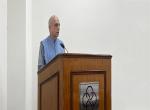The Global Burden of Disease Study reveals that people live longer but with more diseases. The global burden of disease is shifting from infectious diseases to non-communicable diseases; chronic conditions such as diabetes, heart disease, stroke, cancers, and mental illness have become the most frequent diseases and the chief causes of death globally. Long-term palliative care and improvement in quality of life are of utmost importance in the management of these conditions.
Despite the phenomenal progress in medical science, there are treatment gaps and unmet needs in global health care. Traditional medicine in its country of origin and complementary and alternative medicine in other countries are gaining visibility and popularity as potential alternative solutions to fill the gaps in health care.
Around 80% of the world’s population is estimated to use traditional medicine. 170 of the 194 WHO Member States have reported using traditional medicine. Their governments have asked for the WHO’s support in creating a body of reliable evidence and data on traditional medicine practices and products.
Holistic Health means an approach to wellness that simultaneously addresses health's physical, mental, emotional, social, and spiritual components. In its application, holistic medicine is transdisciplinary and relies on many disciplines, religions, spiritual traditions, and cultures to heal people, communities, and also the environment. Holistic health assumes importance in the context of Universal Health Coverage, Sustainable Development Growth (SDG) 3, and the themes of ‘One Earth and One Health’. Traditional systems of medicine can play a major role in making holistic health an integral part of the global healthcare system. Local communities have lived in intimate contact with nature throughout the ages and developed sustainable ways to use biodiversity for human subsistence and development.
Access to diverse approaches to health care integrated within an evidence-based framework, a Patient-centric approach rather than a system-centric approach to health care, and community empowerment and self-reliance are some of the relevant themes in the context of traditional medicine and holistic health.
Overemphasis on curative medicine has also led to the neglect of approaches to nurturing positive states of health and wellness, which is emphasized in traditional systems of medicine. There is a need to nurture healthy lifestyles, diet habits, and home remedies to prevent diseases, which have been part and parcel of traditional healthcare approaches.
India brings a unique vision for holistic health to G20. India is one of the rare examples where medical pluralism prevails, and diverse healthcare systems have legal sanctions. The rich experiences of AYUSH communities in India offer micro-success stories that can be developed into strategies for global implementation.
Ayurveda is a healthcare system that has emerged from communities living in close contact with nature. The very word Ayurveda encompasses life in totality, not only human life but all life forms. Ayus means life, and Veda means knowledge. There is Ayurveda for humans, Vrikshayurveda for plants, and Mrigayurveda for animals.
When we talk about person-centered medicine today, it is important to point out that Ayurveda is a good example of personalized medicine. However, Ayurveda is, first and foremost, nature-centric. Ayurveda points out that the human being is the epitome of the Universe. The macrocosm had given birth to the microcosm. The microcosm is a miniature Universe in itself but is embedded in the macrocosmic web. Health is not possible if nature is not in harmony with itself. Health is not possible if we are not in harmony with nature. Health is not possible if we are not in harmony with ourselves.
Ayurveda defines health as an internal balance of the human body and the outcome of optimal interaction with the external environment. For this reason, preserving the health of the external environment is considered indispensable for human health.
Ayurvedic texts have described the mass destruction of human settlements as the outcome of environmental disturbances. Air, Water, Land, and Climate are factors that need to be maintained within normal parameters for life to be sustained on this planet. Even epidemic diseases and pandemics are the results of imbalances in the environment.
Dharma means sustainability in one sense. According to Ayurveda, dharma is the way to sustainable human development and preserve natural resources and our planet earth. The texts point out that all actions of living beings are for happiness, but without making these actions sustainable (dharmic), it is impossible to achieve happiness.
The ultimate dharma is the recognition of the unity of the entire creation as the expression of one consciousness. ‘One Earth and One Health’ concepts culminate in the experience of One Consciousness. In fact, One Earth and One Health assume relevance in the overarching theme of ‘One Consciousness’. The Ayurvedic discussion on Dharma as the basis for happiness and health is derived from the Vedic vision reflected in hymns like Bhusūkta, Bhūmisūkta, Puruṣasūkta as so on. The peace invocation for Puruṣasūkta aspires for the well-being of the forces of nature, human beings, plant life, and all two-legged and four-legged creatures.
Sustainable Development Goals (SDGs) can be considered strategies for dharmic action from the Ayurvedic viewpoint. Sadvrittam is the code of conduct for sustainable living in Ayurveda.
Humans must utilize natural resources for their subsistence and development, including plants, animals, and other inanimate resources. Thus, some injury (himsa) to other life forms is inevitable. However, it is important to ensure we do not cross the limits. Ayurveda distinguishes between dharmahimsa and kamahimsa. Dharmahimsa is sustainable use of plant and animal life for human needs, where as kamahimsa is unsustainable. Using biodiversity for human greed is kamahimsa. This cannot be sustained for long. Ayurveda gives us a balanced outlook on life, pointing out that one form of life is food for another and that food diversity and self-control are ways to achieve sustainable food security.
The well-being of the entire creation is emphasized in Ayurvedic texts. This assumes significance because Ayurveda uses bio-diversity for medicines and therapeutic procedures, including plant and animal-derived substances. The texts emphasize that Ayurveda is driven by compassion for all living beings - sarvabhūtānukampā. Sadvritta, a protocol for sustainable living, urges every human being to look upon the entire creation, including insects and ants, as the manifestation of one’s self.
The scope of Ayurveda includes both curative (āturavṛttaṃ) and preventive (svasthavṛttaṃ) medicine. Preventive medicine was given utmost importance in ancient India. So much so that non-Ayurvedic Sanskrit literature is replete with health information that is not even found in the classical Ayurvedic texts themselves. This finding testifies that India nurtured and developed a health culture or Ārogyasaṃskṛti, and health information was disseminated through the vast literature. Epics like Mahabharata and Ramayana, as well as the poems of Kalidasa, contain information on healthy living.
Just as Ayurveda focuses on the well-being of all forms of life, it also emphasizes that the goal of society should be to achieve health for all humans. Ayurveda does not identify itself with any geographical region. The texts point out that Ayurveda is the outcome of the interaction of human beings with the biodiversity around them. The knowledge of Ayurveda is, therefore, global. The principles of Ayurveda are universal. However, these principles are to be applied in a locally relevant manner.
Ayurveda points out that traditional medical knowledge consists of principles, theories, and practices. The practices are specific to geographical regions and evolve according to the times. The theories are also models of reality that may be reworked from time to time. The principles are the laws of nature that do not change.
Rediscovering the underlying principles of Ayurveda, remodeling the theories to make it relevant to our times and needs, and discovering new applications to address current health problems is the formula for the development of Ayurveda today.
Ayurveda recognizes the multidimensional nature of the human being - a composite of the body, mind, and spirit advocating a holistic approach to health care. Ayurveda also recognizes pluralistic approaches to understanding human beings, health, and disease and incorporates rational and spiritual approaches to managing health and disease. Thus, Ayurveda can provide a meta-framework for integrating different healthcare systems.
Ayurveda advocates an inclusive approach to health care. It recognizes pluralistic approaches in health care and acknowledges that diverse approaches to health care will be relevant for different individuals and societies. In fact, every region will have to develop its own customized healthcare delivery system to address the local needs of the people.
Ayurveda has developed a framework that can accommodate different approaches to healing, ranging from counseling to lifestyle to dietary interventions to herbal medicines to minerals and metals, various methods of drug processing and delivery, external and internal therapies, surgery, chemical cautery, thermal cautery, religious interventions, spiritual therapy, energy medicine, bodywork therapy and so on. Thus, Ayurveda includes the entire spectrum of complementary and alternative healing systems and can be considered as one of the early attempts to integrate different medical approaches under one unifying framework. The Carakasamhita discusses about medical pluralism.
Some areas where Ayurveda can contribute to global health by providing a meta framework for health care are given below.
Nature Centered Medicine
Ayurveda advocates a nature centered approach to medicine and health care.
For the people growing in a locality the natural resources around them are the best suited. Lifestyle, Diet and Medications have to be localized according to the geographical conditions and seasons. The experience of traditional medicine in different geographical regions should be used to build new applications of Ayurveda.
Person-Centered Medicine
Ayurveda advocates a person centered approach to medicine. Not only treatment, but lifestyle and diet should also be customized according to individual needs. What works on one person may not work on everyone. So the classical RCT design has to be modified to evaluate Ayurvedic treatments. Assessment of physical and mental constitution with the help of recent advancements in genomics is an exciting area for research.
Integration of Lifestyle, Diet, and Medicine
Ayurveda offers templates to develop a holistic approach to therapeutic interventions that blends Lifestyle, Diet and Medicine in a balanced manner. Usage of medicine can be optimized with carefully planned lifestyle and dietary interventions.
Mind Body Medicine
Ayurveda traces the ultimate cause of disease to personality traits and the interactions between mind and body. Spiritual, Psychological and Behavioral approaches are part of the Ayurvedic approach to healing. Meditation, Mindfulness, Yoga and Spiritual Counseling are potential areas where Ayurveda has rich experience to offer for new research.
Complex Formulations from Herbal, Animal, and Chemical Sources
Ayurveda offers a new perspective in development of complex formulations that work on the principles of synergy. Classical Ayurvedic texts provide templates and examples of combining herbal, animal and chemical drug sources in complex ways to develop formulations that are multi component and multi targeted. Serious research could herald a new era of pharmacogenomics with a shift from molecules to molecular cocktails based on rigorous methods of molecular combinatorics.
Preventive and Predictive Medicine
Ayurveda has laid great emphasis on predicting and preventing disease based on the understanding of constitution. Modern advancements in genetics and traditional knowledge of Ayurveda offer a promising area for collaborative research. Pancakarma or bio-cleansing is a unique preventive intervention in Ayurveda to neutralize and get rid of metabolic wastes that can disturb the functions of the body.
Healthy Ageing
Ayurveda is sometimes referred to as the science of longevity itself. There is great emphasis in Ayurveda on health span as opposed to life span. Healthy ageing with preservation of cognitive abilities and mobility is considered to be achievable by Ayurveda. Rejuvenative therapies and regimens known as Rasayana in Ayurveda has shown much promise in research studies.
Rational Approach to Medicine
One classical text of Ayurveda points out that it deals with knowledge that is not dependent on the statement of a person. Irrespective of who says it, the plant Haritaki will induce purgation.
The theoretical constructs of Ayurveda have been derived through a process of discussion and consensus among the experts in the field (siddhanta).
The core teachings of Ayurveda consists of such knowledge verified by experts (verbal testimony – aptopadesa), which can be challenged and verified again by direct observation (pratyaksa) and inference (anumana).
The Caraka Samhita points out that clinical outcomes must be validated to distinguish between chance effect (Yadriccha Siddhi) and real effect (Pratiniyamiki Siddhi) of the treatment.
One has to distinguish self-limiting diseases, placebo effect and spontaneous remission from instances of outcomes that can be attributed to active treatment.
Causal relationships should be rigorously studied by using parameters like Sensitivity (Avinabhavasambandha) and Specificity (Avyabhicaritva).
Causal relationships should be tested by comparing what is tested (paksa) with the positive control (sapaksa) and negative control (vipaksa).
The question arises that if Ayurveda is built on such a rational basis, do we have the evidence that can vouchsafe its safety and efficacy in order for it to be integrated with biomedicine.
The finger is being pointed at Ayurveda not as much because of negative evidence against it but an apparent lack of evidence altogether.
Some kind of negative evidence has surfaced in recent times regarding toxicity of its medicines to due to poor regulation of products and the emergence of spurious medicines in the international market.
Evidence generated through centuries of codification and clinical experience is ill understood because it is not translated into a language that is understood today.
(The paper is the author’s individual scholastic articulation. The author certifies that the article/paper is original in content, unpublished and it has not been submitted for publication/web upload elsewhere, and that the facts and figures quoted are duly referenced, as needed, and are believed to be correct). (The paper does not necessarily represent the organisational stance... More >>
Image Source: https://www.financialexpress.com/wp-content/uploads/2021/11/z6.jpg











Post new comment